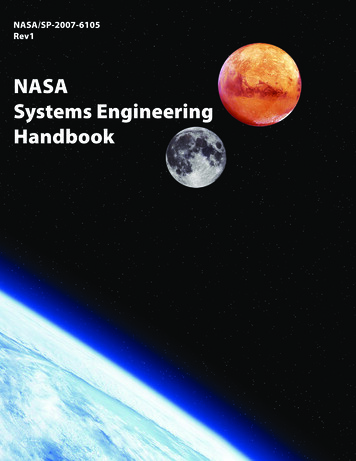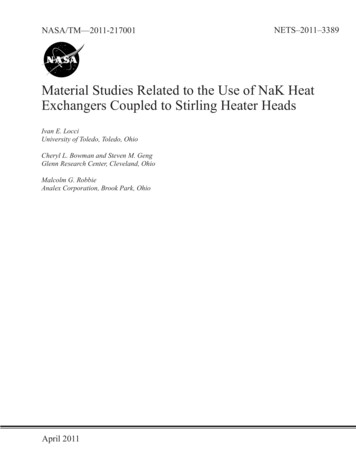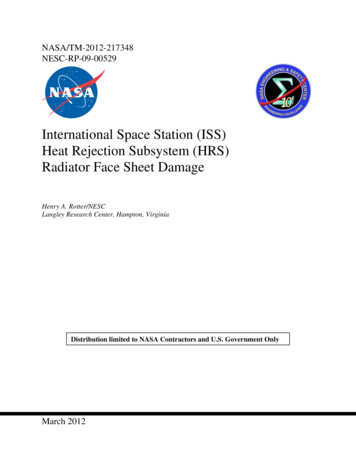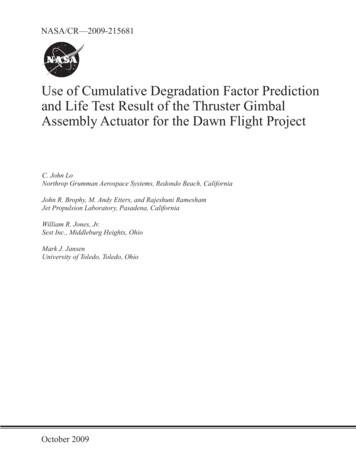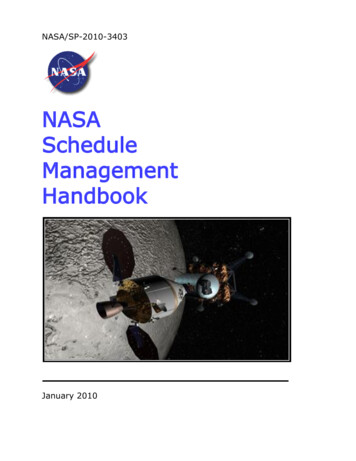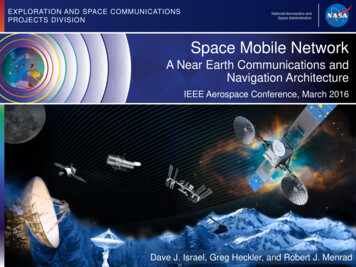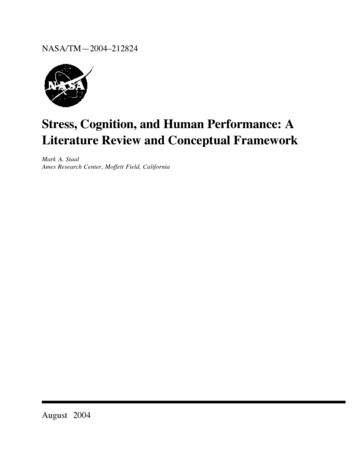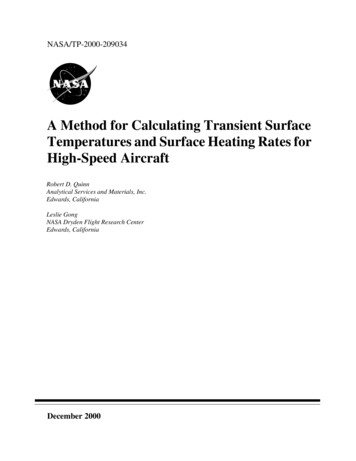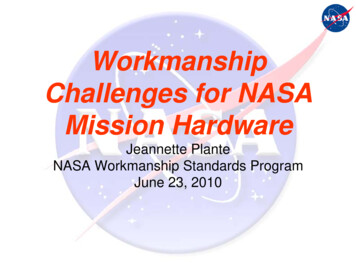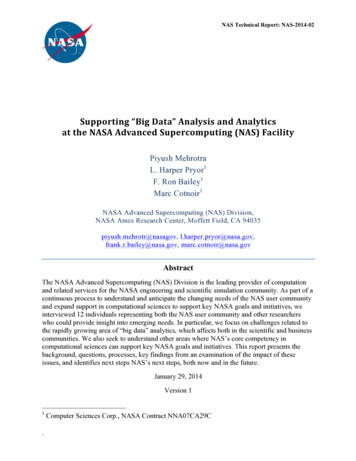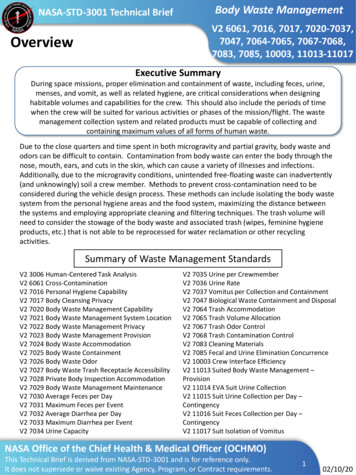
Transcription
Program BookNational Aeronautics andSpace AdministrationLorem ipsum dolor sit amet, consectetueradipiscing elit. Aenean commodo ligula eget dolor.Aenean massa. Cum sociis natoque penatibus etmagnis dis parturient montes, nascetur ridiculusmus. Donec quam felis, ultricies nec, pellentesqueeu, pretium quis, sem. Nulla consequat massaquis enim. Donec pede justo, fringilla vel, aliquetnec, vulputate eget, arcu. In enim justo, rhoncusut, imperdiet a, venenatis vitae, justo. Nullamdictum felis eu pede mollis pretium. Integertincidunt. Cras dapibus. Vivamus elementumsemper nisi. Aenean vulputate eleifend tellus.Aenean leo ligula, porttitor eu, consequat vitae,eleifend ac, enim. Aliquam lorem ante, dapibusin, viverra quis, feugiat a, tellus. Phasellus viverranulla ut metus varius laoreet. Quisque rutrum.Aenean imperdiet. Etiam ultricies nisi vel augue.Curabitur ullamcorper ultricies nisi. Nam egetdui. Etiam rhoncus. Maecenas tempus, telluseget condimentum rhoncus, sem quam semperlibero, sit amet adipiscing sem neque sed ipsum.Nam quam nunc, blandit vel, luctus pulvinar,hendrerit id, lorem. Maecenas nec odio et antetincidunt tempus. Donec vitae sapien ut liberovenenatis faucibus. Nullam quis ante. Etiamsit amet orci eget eros faucibus tincidunt. Duisleo. Sed fringilla mauris sit amet nibh. Donecsodales sagittis magna. Sed consequat, leo egetbibendum sodales, augue velit cursus nunc,Aenean massa. Cum sociis natoque penatibus etmagnis dis parturient montes, nascetur ridiculusmus. Donec quam felis, ultricies nec, pellentesqueeu, pretium quis, sem. Nulla consequat massaquis enim. Donec pede justo, fringilla vel, aliquetnec, vulputate eget, arcu. In enim justo, rhoncusut, imperdiet a, venenatis vitae, justo. Nullamdictum felis eu pede mollis pretium. Integertincidunt. Cras dapibus. Vivamus elementumsemper nisi. Aenean vulputate eleifend tellus.Aenean leo ligula, porttitor eu, consequat vitae,eleifend ac, enim. Aliquam lorem ante, dapibusin, viverra quis, feugiat a, tellus. Phasellus viverranulla ut metus varius laoreet. Quisque rutrum.Aenean imperdiet. Etiam ultricies nisi vel augue.Curabitur ullamcorper ultricies nisi. Nam eget dui.Etiam rhoncus. Maecenas tempus, tellus egetcondimentum rhoncus, sem quam semper libero,sit amet adipiscing sem neque sed ipsum. Namquam nunc, blandit vel, luctus pulvinar, hendreritid, lorem. Maecenas nec odio et ante tincidunttempus. Donec vitae sapien ut libero venenatisfaucibus. Nullam quis ante. Etiam sit amet orcieget eros faucibus tincidunt. Duis leo. Sed fringillamauris sit amet nibh. Donec sodales sagittisNASA Goddard Workshop onArtificial Intelligencewww.nasa.govGoddard Space Flight Center November 27-29, 2018
NASA Goddard Artificial Intelligence WorkshopArtificial Intelligence (AI) is a collection of advanced technologies that allows machines to thinkand act, both humanly and rationally, through sensing, comprehending, acting and learning. AI’sfoundations lie at the intersection of several traditional fields – Philosophy, Mathematics, Economics,Neuroscience, Psychology and Computer Science. Although the inception of AI started in the 1950’s,it has recently made a strong comeback in all aspects of society and all over the world; this is mainlydue to the timely combination of increased data volumes, advanced and mature algorithms, andimprovements in computing power and storage. Current AI applications include big data analytics,robotics, intelligent sensing, assisted decision making, and speech recognition just to name a few.As stated in the latest NSF Statement on AI for American Industry, “The effects of AI will be profound.To stay competitive, all companies will, to some extent, have to become AI companies.” Comparedto Industry and Academia, NASA and Goddard have specific challenges as well as resources that areparticularly adapted to the use of AI.ContentsAgenda.3Keynote Speakers.7Invited Speakers.11Panel Members.16Short Talks.27Posters.482 NASA GODDARD AI WORKSHOP
Workshop AgendaDAY 1TUESDAY,NOVEMBER 27, 20187:30 am – 9:00 amARRIVALGoddard Badging for non-NASA Attendees at the Visiting CenterWorkshop Check-in for All Outside of Building 8 Auditorium9:00 am – 10:30 amOPENING CEREMONYJacqueline Le Moigne, Chair – General Introduction to the WorkshopChristopher Scolese, Director, NASA Goddard – Welcome and Speaker IntroductionKEYNOTE: David Gunning, DARPADARPA’s Explainable Artificial Intelligence (XAI) Program10:30 am – 10:45 amBREAK10:45 am – 12:25 pmPANEL: AI at NASA(Session Chair: Jacqueline Le Moigne)Dan Crichton/JPL – Data Science at JPL: Integrating Data Analytics into the Full Data LifecycleJames Ecker/LaRC – Deep Learning for Neuro-visualization and ContinuousControl in Autonomous SystemsNikunj Oza/ARC – Artificial Intelligence in the NASA Ames Intelligent Systems DivisionBrian Roberts/GSFC – AI & Computer Vision for Satellite Servicing at NASA GoddardBrian Thomas/HQ – Elements of an AI/ML Architecture for NASA12:25 pm – 1:30 pmLUNCH1:30 pm – 2:30 pmKEYNOTE: Kirk Borne, Booz Allen (Introduction: Barbara Thompson)AI at NASA: From Data to Insights to Actionable Intelligence2:30 pm – 4:40 pmSESSION 1Invited Talk: Bart Paulhamus, APL (Introduction: Ron Zellar)Intelligent Systems Research at JHU/APLSHORT TALKS: (Session Chairs: Ioana Rus and Dave Batchelor)3:00 – D. Sekora, AI’s Missing Real-World Connection, and Its Essential and Multifaceted Roles3:10 – J. Nanda, Explainable Machine Learning for Aviation Safety Assurance3:20 – A. Deane, A Cognitive Processing Enhanced Smart Interface FrameworkFor Situational Awareness3:40 – W.R. Huang, Data Poisoning Attacks Can Compromise Machine Learning SystemsBreak: 3:50 pm to 4:00 pmNASA GODDARD AI WORKSHOP 3
Workshop Agenda(Session Chairs: Alinda Mashiku and Manohar Deshpande)4:00 – B. Dean, Deep Multi-Layer Networks for Optical Wavefront Sensing and Control4:10 – S.R. Alimo, Machine Learning Approaches for General Satellite Maneuvers4:20 – A. Mashiku, Supervised-machine Learning for Intelligent Collision AvoidanceDecision-making and Sensor Tasking4:30 – J. Krishnan, SEVA-OIE: Open Information Extractor for the Systems EngineeringVirtual Assistant (SEVA)4:40 pm – 5:45 pmIntroduction Breakout Sessions: Burcu Kosar and Jacqueline Le MoigneBREAKOUT SESSION: AI for NASA Science ApplicationsDAY 2WEDNESDAY,NOVEMBER 28, 20188:30 am – 9:40 amIntroduction: Christyl Johnson, NASA GoddardKEYNOTE: William Buzz Roberts, NGAReal World Artificial Intelligence, Automation and Augmentation – GeospatialIntelligence Successes, Challenges and Way Forward9:40 am – 11:00 amPANEL: AI in Academia(Session Chair: Grey Nearing)Cynthia Matuszek/UMBC – Learning Grounded Language For and From InteractionRay Ptucha/RIT – Deep Learning on Graph DataDinesh Manocha/UMD – Autonomy and AI Research at UMD11:00 am – 11:30 amBREAK11:15 am – 12:15 pmKEYNOTE: Henry Kautz, NSF(Introduction: Jacqueline Le Moigne)Artificial Intelligence: Everything Old is New Again12:15 pm – 12:45 pmBREAK – Grab Lunch12:45 pm – 1:15 pmBrown Bag Lunch with Lika Guhathakurta, NASA ARC (Introduction: Michael Kirk)The Frontier Development Lab (FDL): Applied Artificial Intelligence for Scienceand Exploration1:15 pm – 1:30 pmBREAK4 NASA GODDARD AI WORKSHOP
Workshop Agenda1:30 pm – 2:40 pmSESSION 2Invited Talk: Tom Goldstein, UMD (Introduction: Nargess Memarsdeghi)Multi-Scale Neural Networks for Image ProcessingSHORT TALKS: (Session Chairs: Barbara Thompson and Ryan McGranaghan)2:00 – Z.liu, Improving NASA Earth Science Data and Information Access Through NaturalLanguage Processing Based Data Analysis and Visualization2:10 – M. Reiss, Improvements On Coronal Hole Detection Using Supervised Classification2:20 – K. Tran, X-Net: Bimodal Feature Representation Learning in Satellite Imagery2:30 – S. Sabogal, Hybrid Semantic Image Segmentation using Deep Learning forOn-board Space Processing2:40 pm – 2:50 pmBREAK2:50 pm – 4:20 pmSESSION 3Invited Talk: Victor Pankratius, MIT (Introduction: Sujay Kumar)Towards Deriving Theories from Data: Frontiers for Model Inferencein Astro-&GeophysicsSHORT TALKS: (Session Chairs: Craig Pelissier and Troy Ames)3:20 – C. Keller, Atmospheric Chemistry Modeling using Machine Learning3:30 – J. Kouatchou, Implementation of Gaussian Processes in an Hydrological Model3:40 – D. Josyula, Autonomous Seasonality Adaptation3:50 – N. Thomas, Machine Learning in Global Scale Classification of Mangrove Forests Fromremotely sensed imagery4:00 – T. Maxwell, Machine Learning in the Earth Data Analytic Services (EDAS) Framework4:10 – M. Halem, RNN/LSTM Ensemble Data Assimilation for the Lorenz Chaotic Models4:20 pm – 5:10 pmBREAKOUT SESSION: AI for NASA Engineering Applications5:10pm – 5:30 pmBREAK (and Poster Setup)5:30 pm – 6:30 pmPOSTER SESSIONDAY 3THURSDAY, NOVEMBER 29, 20188:30 am – 9:40 amIntroduction: Peter Hughes, NASA GoddardKEYNOTE: Vikash Mansinghka, MITProbabilistic Programming and Artificial IntelligenceNASA GODDARD AI WORKSHOP 5
Workshop Agenda9:40 am – 11:25 amPANEL: AI in Industry (Session Chair: Ron Zellar)John Hebeler/Lockheed Martin –Determining Normal (and Abnormal) using Deep LearningGraham Katz/IBM – Watson Intelligent Advisors: Discovery and Conversational Technologyfor Now and the FutureJon Neff/Aerospace – Overview of Aerospace Corporation AI InitiativesSusie Adams/Microsoft – TBDLarry Brown/NVIDIA – GPU Accelerated High Performance Data Analyticsfor Federal Applications11:25 am – 11:40 am BREAK11:40 am – 12:30 pm SESSION 4BREAKOUT SESSION: AI for Intelligent Mission Autonomy12:30 pm – 1:30 pmLUNCH1:30 pm – 3:10 pmSESSION 5Invited Talk: John Calhoun, Amazon AWS (Introduction: Craig Pelissier)Improving Time to Science Using AWS Machine LearningSHORT TALKS: (Session Chairs: Nargess Memarsadeghi and Jorge Pinzon)2:00 – H. Amiri, Spaced Repetition for Training Artificial Neural Networks2:10 – T. Yuan, “Application of a Deep U-Net to Automatic Detection of Ship-TracksMultispectral Images from both Polar-Orbiting and Geostationary Satellites2:20 – R. McGranaghan, “Ushering in a New Frontier in Geospace Through Data Science2:30 – R. Attié, Tracking Optical Flows for Better Data Mining on Solar Images2:40 – D.Hall, Deep Learning Applied to Satellite Data Processing2:50 – S. Sharma, Data-driven Modeling, Prediction and Predictability: The ComplexSystems Framework3:00 – A. Annex, Automated Stratigraphic Mapping using Convolution Neural Networks3:10 pm – 3:30 pmGENERAL DISCUSSION - CONCLUSIONS and ADJOURN4:00 pm – 5:00 pmSPECIAL TUTORIAL (Organizer: Craig Pelissier)Thursday, November 29Python Anaconda Machine Learning Tutorial6 NASA GODDARD AI WORKSHOP
Keynote SpeakersKirk BorneBooz Allenkirk.borne@gmail.comAI at NASA: From Data to Insights to Actionable IntelligenceAbstract: This keynote presentation will probe the power of data to inform, predict, and automate nextbest actions in a scientific exploration enterprise. Data from sensors are the input to intelligent systems-- in operational environments, streaming data provide the fuel to drive discovery, insights, and decisionsupport through AI. AI is more than artificial intelligence -- it is accelerated, actionable, adaptable,amplified, assisted, and augmented intelligence. Example use cases will be presented for these typesof implementations. AI is also applied intelligence, for cases ranging from safety to security to systemsto scientific discovery. Methods, relevant opportunities, and some typical algorithms will be presented.Emphasis will be given to machine learning techniques, which are algorithms that learn from experience.In other words, these are algorithms that discover patterns in data and then learn a model that helpsto recognize those patterns again or to identify emerging new patterns. Examples will be given fromspace weather, remote sensing, planetary exploration, and planetary protection. Some of the top trendsin AI, machine learning, and data science will be presented also -- first, these will be introduced in ageneral way, followed by their potential applications in NASA science and engineering projects. Finally,some speculations will be offered on concepts like AI and 4-D printing, AI on a chip, and blockchain forexplainable AI (XAI).Bio: Dr. Kirk Borne is the Principal Data Scientist and an Executive Advisor at global technology andconsulting firm Booz Allen Hamilton based in McLean, Virginia. In those roles, he focuses on applicationsof data science, data management, machine learning, AI (machine intelligence), modeling, and simulationacross a wide variety of disciplines. He also provides training and mentoring to multi-disciplinaryteams of scientists, modelers, and data scientists. In addition, he consults with numerous externalorganizations, industries, agencies, and partners in the use of large data repositories and machinelearning for discovery, decision support, and innovation. Previously, he was Professor of Astrophysicsand Computational Science at George Mason University for 12 years where he did research, taught,and advised students in data science. Prior to that, Kirk spent nearly 20 years supporting data systemsactivities on NASA space science programs, which included a period as NASA’s Data Archive ProjectScientist for the Hubble Space Telescope and 10 years as a contract manager in NASA’s Space ScienceData Operations Office at the Goddard Space Flight Center. Dr. Borne has a B.S. degree Summa CumLaude in Physics from LSU, and a Ph.D. in Astronomy from Caltech. In 2016 he was elected Fellow of theInternational Astrostatistics Association for his lifelong contributions to big data research in astronomy.In addition to hundreds of invited talks worldwide, he has also presented keynote presentations at manyNASA GODDARD AI WORKSHOP 7
Keynote Speakersdozens of data science and analytics conferences globally. He is an active contributor on social media,where he has been named consistently among the top worldwide influencers in big data and datascience since 2013. You can follow him on Twitter at @KirkDBorne.David GunningDARPAdavid.gunning@darpa.milDARPA’s Explainable Artificial Intelligence (XAI) ProgramAbstract: The goal of XAI is to create a suite of new or modified machine learning techniques thatproduce explainable models that, when combined with effective explanation techniques, enable endusers to understand, appropriately trust, and effectively manage the emerging generation of AI systems.Dramatic success in machine learning has led to an explosion of new AI capabilities. These systemswill offer tremendous benefits, but their inability to explain their actions to human users will limit theeffectiveness of these systems. There is an inherent tension between machine learning performance(predictive accuracy) and explainability; often the highest performing methods (e.g., deep learning) arethe least explainable, and the most explainable (e.g., decision trees) are less accurate. The program isfunding a variety of machine learning techniques to provide future developers with a range of designoptions covering the performance versus explainability trade space. XAI is focusing these developmentson addressing challenge problems in two areas: (1) machine learning problems to classify events ofinterest in heterogeneous, multimedia data, and (2) machine learning problems to construct decisionpolicies for a simulated autonomous system.Bio: David Gunning is DARPA program manager in the Information Innovation Office (I2O). Dave hasan over 30 years of experience in the development of artificial intelligence (AI) technology. At DARPA,Dave manages the Explainable AI (XAI) and the Communicating with Computers (CwC) programs. Thisis Dave’s 3rd tour as a DARPA PM. Previously, Dave managed the Personalized Assistant that Learns(PAL) project that produced Siri and the Command Post of the Future (CPoF) project that was adoptedby the US Army as their Command and Control system for use in Iraq and Afghanistan. In betweenDARPA tours, Dave was a Program Director for Data Analytics at the Palo Alto Research Center (PARC),a Senior Research Manager at Vulcan Inc., SVP of SET Corp., VP of Cycorp, and a Senior Scientist inthe Air Force Research Labs. Dave holds a M.S. in Computer Science from Stanford University, a M.S.in Cognitive Psychology from the University of Dayton, and a B.S. in Psychology from Otterbein College.8 NASA GODDARD AI WORKSHOP
Keynote SpeakersHenry KautzNSF, Division Director, Information & Intelligent Systems (CISE/IIS)hkautz@nsf.govArtificial Intelligence: Everything Old is New AgainAbstract: The history of AI is often erroneously summarized as, “AI failed until deep learning camealong”. In fact, the period between the Dartmouth Workshop of 1956 and the deep learning revolutionof 2009 witnessed a steady stream of advances in fundamental models and methods for cognition andcommonsense reasoning, in addition to the work on artificial neural networks (ANNs) that culminatedin deep learning. Applications of much of the non-ANN oriented research, however, was limited by theinadequacy of methods for grounding symbols in real-world phenomena – that is, perception. Nowthat deep learning has made machine perception relatively robust, “old” AI research on cognition andcommonsense is ripe for revisiting. The next AI revolution will be the creation of AI architectures thatsynthesize ANNs and symbolic methods.Bio: Henry Kautz is serving as Division Director for Information & Intelligent Systems (IIS) at the NationalScience Foundation. He is a Professor in the Department of Computer Science and was the foundingdirector of the Goergen Institute for Data Science and at the University of Rochester. He been a departmenthead at AT&T Bell Labs in Murray Hill, NJ, and a full professor at the University of Washington, Seattle.In 2010, he was elected President of the Association for Advancement of Artificial Intelligence (AAAI),and in 2016 was elected Chair of the American Association for the Advancement of Science (AAAS)Section on Information, Computing, and Communication. His research in artificial intelligence, pervasivecomputing, and healthcare applications has led him to be honored as a Fellow of the AAAS, Fellow ofthe AAAI, and Fellow of the Association for Computing Machinery.William Buzz nasa.govReal World Artificial Intelligence, Automation, and Augmentation – Geospatial Intelligence Successes,Challenges and Way ForwardAbstract: With the growth in commercially available geospatial information and remote sensing, as wellas the democratization of science and technologies to make sense of it, characterizing our changingplanet remains a daunting task. The National Geospatial Intelligence Agency’s (NGA) Artificial Intelligence,NASA GODDARD AI WORKSHOP 9
Keynote SpeakersAutomation and Augmentation (AAA) strategy, plans and actions are focused on maximizing the potentialinformation and knowledge from this growing corps of data and reducing the data to decision timelinesto meet time sensitive missions like humanitarian assistance, disaster response and safety of navigation.Successes, challenges and realities are forming NGA’s way forward on its AAA activities. Informingresearchers, practitioners and decision makers with real world results, gaps and challenges is critical toNGA’s mission success. The speaker will share success stories on how AAA is currently being applied toaugment a variety of NGA missions towards geospatial-intelligence as the speed of human understanding.Bio: Mr. William T. “Buzz” Roberts currently serves as the Analytic Automation POD Lead within theResearch Directorate of the National Geospatial-Intelligence Agency (NGA). He’s responsible for leading,coordinating, and developing state-of-the-art analysis methods, processes, skills and technologies toadvance geospatial intelligence analysis, functional capabilities, operations, personnel training and skills,technologies and architectures of the National System for Geospatial-Intelligence (NSG) and Allied Systemfor Geospatial-Intelligence (ASG). Prior to this, Mr. Roberts served as the inaugural Director, ArtificialIntelligence, Automation and Augmentation for NGA.Mr. Roberts’ more than 36 years of service in the Intelligence and GEOINT community began in March of1982 upon entering the United States Air Force as an Imagery Analyst. After his Air Force retirement, heimmediately began his civilian career, with NGA’s legacy organization the National Imagery and MappingAgency (NIMA), in July of 2004.Throughout his career he’s held numerous military and civilian positions in a variety of capacities at tactical,operational and theater command headquarters levels, as well as service staffs, national agency and nationalsenior decision maker levels. His numerous positions within the Intelligence Community and Departmentof Defense Intelligence, Surveillance and Reconnaissance (ISR) community spanned intelligence analysis,collection management, operations, planning and programming, training, resource and human capitalmanagement and advanced science and technologies activities. His service includes 16 years of overseasassignments. His lengthy operational and intelligence expertise is highlighted by a distinguished andproven career of operations excellence and transformation and innovative improvements in intelligence,decision, warfighting, acquisition, training and science and technology operations and capabilities.Mr. Roberts is a 2016 graduate of the National War College, with a Master of Science in National SecurityStudies. He also is a graduate of University of Maryland University College with Master of Science inTechnology Management, Master of Business Administration and Bachelor of Science in Computerand Information Science degrees. He is Defense Acquisition Program Management and Science andTechnology Program Management, level 3 certified.He is a native of Royal Oak, Michigan and is an active community member and enjoys participating invarious academic, sporting and outdoor activities. He is married to the former Ms. Patricia Ann Rich. Theyhave a blended family of six adult children; Kasey, Samira, Jesse, Daniel, Andrew and Heather and live inFauquier County, Virginia.10 NASA GODDARD AI WORKSHOP
Invited SpeakersJames A. BednarSenior Technical Consultant, Anaconda, Inc.jbednar@anaconda.comPython Tools for Geoscience Research Using Machine Learning and AIAbstract: Python is a very popular choice for machine-learning and artificial-intelligence applications,in part because of its–– wide range of available ML/AI algorithms–– support for easily transforming data into a usable form–– tools for big-data visualization and analysis–– support for automating complex and computationally intensive data processingHowever, it can be difficult to determine the best way to approach any specific problem in such a generalframework. Earth-science and climate data also present specific difficulties that can make NASA-relateddata workflows awkward, error-prone, time consuming, and limited in data size and complexity.The EarthML project (EarthML.pyviz.org) is a new joint initiative between NASA Goddard and Anaconda,Inc. to make it simpler to apply machine-learning and related techniques to satellite imagery, climatemeasurements, and other data sources used by NASA.EarthML consists of:1. Best-practice examples of using open-source Python libraries in complete data pipelines includingdata preparation, visualization, and analysis (EarthML.PyViz.org and EarthSim.PyViz.org).2. Improvements to underlying libraries for scalable visualization (PyViz.org), scalable data processing(Dask.pydata.org), and multidimensional data cataloging and retrieval (Intake.readthedocs.io andXArray.pydata.org).3. Documentation and training materials to make it easier to get started with each of these libraries(EarthML.PyViz.org and EarthSim.PyViz.org).4. We will demonstrate these tools with examples of satellite image segmentation via spectralclustering, tagging data on maps as ML training examples, and predicting climate variables ofinterest from local or satellite measurements.Bio: Jim Bednar leads the PyViz group at Anaconda, working with commercial and government clientsto improve Python software for visualizing and analyzing large and complex datasets. Dr. Bednar holdsan M.A. and a Ph.D. in Computer Science from the University of Texas, along with degrees in ElectricalEngineering and Philosophy. He has published more than 50 papers and books about the visual systemand about software development. Dr. Bednar manages the open source Python projects PyViz, Panel,Datashader, HoloViews, GeoViews, Param, Colorcet, and ImaGen. Before Continuum, Dr. Bednar was alecturer and researcher in computational neuroscience at the University of Edinburgh, Scotland, as wellas a software and hardware engineer at National Instruments.NASA GODDARD AI WORKSHOP 11
Invited SpeakersJohn CalhounAmazon AWSjcalho@amazon.comImproving “Time to Science” Using AWS Machine LearningAbstract: In this presentation we will talk about how machine learning is being used in science todiscover new results and how AWS can accelerate those machine learning workloads.Bio: John Cahoun is a solutions architect on Amazon Web Services (AWS) public-sector partners teamwho specializes in machine learning. Before AWS John was a mathematician who did research andeducation around machine learning. Now at AWS he works closely with a wide variety of customers,helping them meet their missions by adopting and using machine learning.Tom GoldsteinUMDtomg@cs.umd.eduMulti-scale Neural Networks for Image ProcessingAbstract: We present Stacked U-Nets, a simple neural net architecture that combines the informationglobalization properties of multigrid solvers with the expressive power of neural nets. Stacked U-Netsare very effective for image processing problems, and achieve state of the art performance on imagesegmentation using relatively few parameters.Bio: Tom Goldstein is an Assistant Professor at the University of Maryland Department of ComputerScience. His research lies at the intersection of optimization and distributed computing, and targetsapplications in machine learning computer vision. Tom designs intelligent systems for a wide rangeof platforms. This includes powerful cluster/cloud computing environments for machine learning andcomputer vision, in addition to resource limited integrated circuits and FPGAs for real-time signalprocessing. Tom’s research takes an integrative approach that considers algorithms and hardware tobuild practical high performance systems, and theoretical studies to understand how these systemswork. Before joining the faculty at Maryland, Tom completed his PhD in Mathematics at UCLA, and wasa research scientist at Rice University and Stanford University. Tom has been the recipient of severalawards, including SIAM’s DiPrima Prize, a DARPA Young Faculty Award, and a Sloan Fellowship.12 NASA GODDARD AI WORKSHOP
Invited SpeakersMadhulika (Lika) GuhathakurtaARC (SETI)mguhathakurta@gmail.comApplied Artificial Intelligence for Science & ExplorationAbstract: The recent advances in Artificial Intelligence (AI) capabilities are particularly relevant to NASAHeliophysics because there is growing evidence that AI techniques can improve our ability to model, understandand predict solar activity using the petabytes of space weather data already within NASA archives. Thisrepresents a strategic opportunity, since the need to improve our understanding of space weather is not onlymandated by directives such as the National Space Weather Action Plan and the Presidential Executive Orderfor Coordinating Efforts to Prepare the Nation for Space Weather Events, but also because space weather isa critical consideration for astronaut safety as NASA moves forward with the Space Policy Directive to leaveLEO and return to the Moon.The Frontier Development Lab (FDL) is an AI research accelerator that was established in 2016 to applyemerging AI technologies to space science challenges which are central to NASA’s mission priorities. FDL is apartnership between NASA Ames Research Center and the SETI Institute, with corporate sponsors that includeIBM, Intel, NVidia, Google, Lockheed, Autodesk, Xprize, Space Resources Luxembourg, as well as USC andother organizations. The goal of FDL is to apply leading edge Artificial Intelligence and Machine Learning (AI/ML) tools to space challenges that impact space exploration and development, and even humanity.Bio: LAs a NASA astrophysicist, Dr. Madhulika Guhathakurta (also known as Lika) has had the opportunityto work as a scientist, mission designer, instrument builder, directing and managing science programs andteacher and spokesperson for NASA’s mission and vision in the Heliophysics Division. Occasionally, sheperforms all of these roles in a single day. Before joining NASA Headquarters in December of 1998, her careerhas focused on studying the importance of the scientific exploration of space in particular understandingthe Sun as a star and its influence on the planet Earth, with research focus on understanding the magnetohydrodynamics of the Sun’s outermost layer, the solar corona. She has been a Co-Investigator on five Spartan201 missions on aboard space shuttles (STS-56, STS-64, STS-69, STS-87, STS-95) to study the solar coronain white-light and UV radiation and nine eclipse expeditions. She has led the Living with a Star Program forthe past 15 years whose goal is to understand and ultimately predict solar variability and its diverse effects onEarth, human technology and astronauts in space, also known as “Space Weather”. She has led missions suchas STEREO, SDO, Van Allen Probes, Solar Orbiter Collaboration, Parker Solar Pro
Artificial Intelligence (AI) is a collection of advanced technologies that allows machines to think and act, both humanly and rationally, through sensing,

